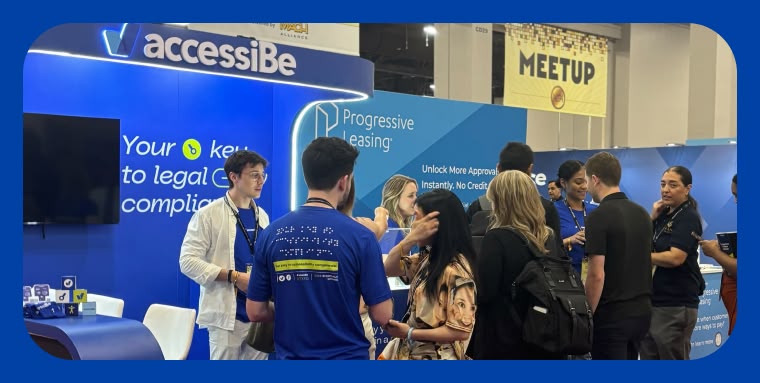This year’s Shoptalk conference brought together the biggest names in retail and eCommerce to explore what’s next for the industry.
From AI-driven personalization to frictionless omnichannel experiences, innovation was everywhere. But one theme that continues to demand attention is digital accessibility.
The accessiBe team was there to connect, learn, and advocate for a more inclusive web.
Here’s what stood out to us at the show.
But first, some raw numbers

Shoptalk 2025 brought the global retail community to Las Vegas, drawing more than 10,000 attendees and upwards of 2,500 retailers and brands from 42 countries.
The expo floor featured more than 600 tech providers, while the Hosted Meetings Program facilitated over 9,000 curated connections between buyers and solution providers.
With names like Walmart, IKEA, and L’Oréal in attendance, the event cemented its role as a central hub for retail innovation; a place where ideas are shared, deals are made, and the future of commerce is shaped.
A significant share of attendees represented online-first and hybrid retailers, including DTC disruptors and marketplaces. In fact, over 60% of brand and retailer participants had a digital or eCommerce title - a clear sign that digital strategy is no longer a siloed function, but, rather, the foundation of modern retail.
And the timing makes sense: with U.S. eCommerce sales projected to reach $1.5 trillion by 2027, the push for digital transformation and digital compliance is gaining serious momentum.
So, what did we actually learn at Shoptalk?

After speaking with hundreds of attendees - from solo DTC founders to digital leaders at global retailers - we walked away with a few key insights. These stood out across conversations, regardless of company size or tech stack, and felt relevant to the state of eComm as a whole:
1. Awareness of web accessibility is still low across the eCommerce sector
At Shoptalk, we heard this firsthand: plenty of eComm professionals had never seriously considered how people with disabilities navigate their sites, or whether they can navigate them at all. For some, this was the first time accessibility had even come up in a business context.
This is not due to apathy, but rather a visibility issue.
Accessibility still isn’t framed as a standard part of building and maintaining an online store, despite its direct impact on usability, customer experience, and revenue.
2. Many store owners still don’t understand their legal responsibilities
This gap in awareness also extends to the legal landscape.
Many store owners aren't clear on how laws like the Americans with Disabilities Act (ADA) apply to their websites. Some assume these regulations only apply to brick-and-mortar stores or enterprise-level companies.
In reality, online retailers of all sizes are at risk of receiving demand letters or facing lawsuits for having inaccessible websites.
With retail and eCommerce remaining the most commonly targeted industries for accessibility litigation, this knowledge gap is both a legal liability and a missed opportunity to drive long-term success.
3. Accessibility and compliance goals can be met, no matter the platform
Even among attendees who were somewhat familiar with digital accessibility, many didn’t realize that solutions exist which can integrate directly with their existing CMS or site builder.
We heard variations of the same concern from store owners, marketers, and tech leads: that addressing accessibility might require a full rebuild, major development work, or even switching platforms entirely.
While optimal accessibility calls for a multi-layered approach, many critical accessibility gaps can be tackled quickly and effectively on a per-session basis using AI-driven technology.
On more than one occasion, accessiBe team members demonstrated this in action, showing how accessWidget integrates seamlessly with platforms like Shopify, WooCommerce, BigCommerce, and others.
Regardless of the CMS or site builder in use, we showed that accessibility efforts don’t have to start with a complete overhaul. Instead, they can begin with straightforward, AI-driven solutions that help businesses take immediate steps toward inclusion and compliance - within their existing setup.
Looking forward to 2026
If there’s one thing we expect to hold steady between now and next year’s show, it’s this: digital accessibility will only become more urgent for the eCommerce sector.
Retail and online stores remain the most frequently targeted industries in ADA-related legal action, and that trend shows no signs of slowing. As legal scrutiny continues to rise, and consumers expect more inclusive digital experiences, compliance will become an even greater priority for businesses across the board.
Momentum is also picking up internationally.
With the European Accessibility Act (EAA) set to come into effect in June 2025, we anticipate a wave of renewed focus from European retailers—especially those selling across borders or operating on global platforms.
For many, this will mark a turning point: accessibility will no longer be optional, but essential to doing business in the EU.
As always, accessiBe will be here to help businesses navigate what’s ahead.
We’ll be back at Shoptalk next year, ready to continue the conversation, share what we’ve learned, and help ensure accessibility stays at the center of digital progress.
